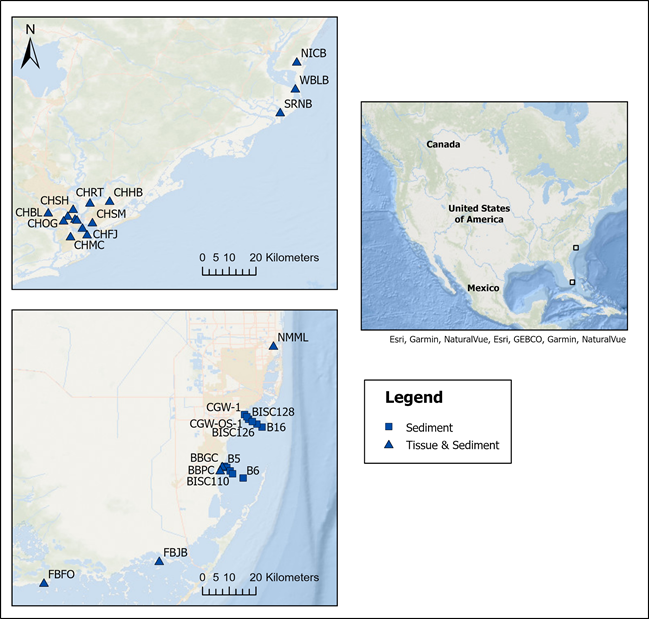
Mussel Watch team members break apart clumps of oysters from Charleston Harbor, South Carolina, to prepare samples for analysis. Credit: NOAA.
The Mussel Watch Program has monitored the nation’s coastal waters for chemical contaminants since 1986 and in recent decades has expanded its monitoring to include trace metals, legacy contaminants, and contaminants of emerging concern (CECs). In 2020, the program collected oyster (Crassostrea virginica) samples from a network of 31 sites in the Southeast Atlantic. Results from this study will support a better understanding of the sources, fate, and transport of contaminants in the region and will fill important data gaps for local stakeholders.
Why We Care
Charleston Harbor serves as the major port for the city of Charleston, South Carolina, and is part of the Intracoastal Waterway. The harbor has undergone extensive dredging for decades, potentially affecting water quality. In Florida, the Atlantic coast has a range of land uses, including some densely populated cities, national parks and wildlife refuges, rural areas, and many barrier islands. Thousands of chemical contaminants from many land-based point and nonpoint sources accumulate in the Southeast Atlantic every day, compromising water quality and, consequently, threatening human and ecosystem health.
Previous studies in the region have investigated legacy contaminants, such as trace elements and persistent organic pollutants (e.g., polychlorinated biphenyls (PCBs), organochlorine pesticides, chlordane, and polycyclic aromatic hydrocarbons (PAHs)). These research and monitoring efforts have helped managers limit the impact that legacy contaminants have on coastal ecosystems, but such efforts are lacking for the increasing number of new and unregulated compounds known as contaminants of emerging concern (CECs), many of which are known to be harmful to people, animals, and the environment. In response to resource managers’ concerns about the extent and impact of these chemical stressors, the Mussel Watch Program conducted a basin-wide survey in 2020 to assess the magnitude and distribution of a suite of CECs, metals, and legacy contaminants in the Southeast Atlantic region.
What We Are Doing
The Mussel Watch Program uses an ecosystem-based approach to monitoring, which entails measuring the concentration of chemical contaminants in sediments and the tissues of indigenous bivalves, such as oysters and mussels, as a way to evaluate local environmental quality. Bivalves are used as indicator organisms for chemical pollution because they tend to bioaccumulate contaminants from the large amounts of water they filter, they have limited mobility, and they are found throughout the U.S. coastal zone.
The program currently analyzes sediment and bivalves for both legacy contaminants and CECs. Legacy contaminants, monitored by Mussel Watch since 1986, include compounds such as chlordanes, chlorobenzenes, dichlorodiphenyltrichloroethane (DDT), dieldrins, endosulfans, hexachlorocyclohexanes (HCHs), butyltins, PAHs, and PCBs. The monitoring of CECs began in 2009 and includes contaminants such as alkylphenols, alternative flame retardants, current-use pesticides, (per- and polyfluoroalkyl substances (PFASs), polybrominated diphenyl ether (PBDEs), polybrominated biphenyls (PBBs), and pharmaceuticals and personal care products. In general, CECs are minimally regulated, not commonly monitored, but potentially toxic chemicals that are finding their way into the environment.
In 2020, the Mussel Watch Program analyzed sediment and oyster (Crassostrea virginica) samples from a network of 31 sites in the Southeast Atlantic region for metals, legacy contaminants, and CECs. The team collected 20 oyster and 31 sediment samples along the South Carolina coast, with a focus on Charleston Harbor, and along the Atlantic coast of Florida following standard Mussel Watch Program protocols. Site selection was conducted in collaboration with resources managers from the Atlantic Oceanographic and Meteorological Laboratory and involved a strategic mixture of sites that met both programs’ monitoring needs. The national Mussel Watch Program designed the 2020 Southeast Atlantic region chemical stressors survey in collaboration with NCCOS's Ecotoxicology Branch (Hollings Marine Laboratory) and the Atlantic Oceanographic and Meteorological Laboratory.
Benefits of Our Work
This study supplies much-needed data to the national Mussel Watch Program and local stakeholders and managers in the Southeast Atlantic region and informs water quality data used by coastal resource managers to develop effective, long-term policies to protect ecosystem services provided by the Southeast Atlantic region.

Map of sites sampled in the Southeast Atlantic in 2020 as part of the NOAA Mussel Watch Program. Credit: Lauren Swam, NOAA.
 Official websites use .gov
A .gov website belongs to an official government organization in the United States.
Official websites use .gov
A .gov website belongs to an official government organization in the United States. Secure .gov websites use HTTPS
A lock or https:// means you’ve safely connected to the .gov website. Share sensitive information only on official, secure websites.
Secure .gov websites use HTTPS
A lock or https:// means you’ve safely connected to the .gov website. Share sensitive information only on official, secure websites.